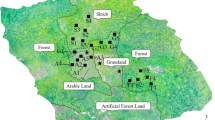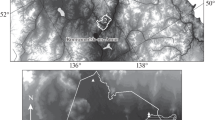Abstract
One hundred and two white spruce (Picea glauca (Moench) Voss) stands were studied in the Sub-boreal Spruce zone of British Columbia and were quantitatively classified into seven soil moisture regimes (moderately dry, slightly dry, fresh, moist, very moist, wet, and very wet) according to actual/potential evapotranspiration ratio, depth to gleyed layer or prominent mottling, and depth to groundwater table. The delineated soil moisture regimes demonstrated strong relationships with the composition of understory vegetation and white spruce foliar nutrients and site index. These relationships implied that the three differentiating characteristics used in the classification provided a good estimation of growing-season soil water supply. In addition to soil moisture regimes, three soil aeration regimes (adequate, restricted, and deficient) were delineated according to presence or absence of gleyed horizons and groundwater table, slope gradient, and soil texture. These soil aeration regimes helped in explaining the variation in white spruce site index, especially on water-surplus sites. Thus, an integrated classification of soil moisture-aeration regimes was proposed to explain the effect of soil moisture and aeration on white spruce productivity.
The results of this study gave further evidence that soil moisture and aeration regimes, differentiated on the basis of climatic data and soil morphological properties, are useful measures of soil moisture and aeration conditions in sub-boreal forest soils.
Similar content being viewed by others
References
AhlgrenC.E. and HansenH.L.: 1957, ‘Some effects of temporary flooding on coniferous trees’, J. For. 55, 647–650.
Anonymous, 1982, ‘Canadian climate normals, 1951–1980 (Vol. 6)’, Environment Canada, Atmospheric Environment Service, Ottawa, Ontario, 276 pp.
BakuzisE.V.: 1969, ‘Forestry viewed in an ecosystem perspective’, In: G.M.VanDyne (ed.), The Ecosystem Concept in Natural Resource Management, Academic Press, New York, pp. 189–258.
BallardT.M.: 1982, ‘Soil interpretation for forestry’, Land Manage. Rep. No. 10, B.C. Min. For., Victoria, British Columbia, pp. 156–167.
BallardT.M. and CarterR.E.: 1986, ‘Evaluating forest stand nutrient status’, Land Manage. Rep. No. 20, B.C. Min. For., Victoria, British Columbia, 60 pp.
BlackT.A.: 1982, ‘Determining soil climate for soil survey’, Land Manage. Rep. No. 10, B.C. Min. For., Victoria, British Columbia, pp. 216–235.
BraisS. and CamireC.: 1992, ‘Keys for soil moisture regime evaluation for northwestern Quebec’, Can. J. For. Res. 22, 718–724.
CajanderA.K.: 1926, ‘The theory of forest types’, Acta. For. Fenn. 2, 11–108.
Canada Soil Survey Committee: 1978, ‘The Canadian system of soil classification’, Can. Dep. Agric. Publ. No. 1646, Supply and Services Canada, Ottawa, Ontario, 164 pp.
CanneellR.Q.: 1977, ‘Soil aeration and compaction in relation to root growth and soil management’, In: T.H.Coaker (ed.), Applied Biology (Vol. 2), Academic Press, New York, pp. 1–86.
CarmeanW.H.: 1972, ‘Site index curve for upland oaks in the Central States’, For. Sci. 18, 109–120.
CarterR.E. and KlinkaK.: 1990, ‘Relationships between growing-season soil water-deficit, mineralizable soil nitrogen and site index of Coastal Douglas-fir’, For. Ecol. Manage. 30, 301–311.
EmanuelJ.: 1987, ‘A vegetation classification program (F405:VTAB)’, (Mimeographed), Faculty of Forestry, Univ. British Columbia, Vancouver, British Columbia, 26 pp.
GerardinV. and DucrucJ.: 1990, ‘An objective approach to evaluating natural drainage of forest mineral soils for non-specialists’, Vegetatio 87, 127–133.
GilesD.G., BlackT.A. and SpittlehouseD.L.: 1984, ‘Determination of growing season soil water deficits on a forested slope using, water balance analysis’, Can. J. For. Res. 15, 107–114.
Green, R.N. and Klinka, K.: 1995, ‘A field guide to site identification and interpretation for the Vancouver Forest Region’, Land Manage. Handb. B.C. Min. For., Victoria, British Columbia, (in press).
GreenR.N., TrowbridgeR.L. and KlinkaK.: 1993, ‘Towards a taxonomic classification of humus forms’, For. Sci. Monogr. 29, 49.
GuthrieT.F. and LoweL.E.: 1984, ‘A comparison of methods for total sulfur analysis of tree foliage’, Can. J. For. Res. 14, 470–473.
HaleJr.M.E. and CulbersonW.L.: 1970, ‘A fourth checklist of the continental United States’, The Bryologist 73, 499–543.
HillsG.A.: 1952, ‘The classification and evaluation of site for forestry’, Res. Rep. No. 24, Ontario Dep. of Lands and Forests, Toronto, Ontario, 41 pp.
HillsG.A.: 1976, ‘An integrated iterative holistic approach to ecosystem classification’, In: J.Thie and G.Ironside (eds.), Ecological (Biophysical) Land Classification in Canada, Lands Directorate, Environment Canada, Ottawa, Ontario, pp. 73–97.
IrelandR.R., BirdC.D., BrassardG.R., SchofieldW.B. and VittD.H.: 1980, ‘Checklist of the mosses of Canada’, National Museum of Natural Science Publication in Botany No. 8, National Museums of Canada, Ottawa, Ontario, 75 pp.
JeglumJ.K.: 1974, ‘Relative influence of moisture-aeration and nutrients on vegetation and black spruce growth in northern Ontario’, Can. J. For. Res. 4, 114–126.
Kayahara, G.J.: 1992, ‘Ecological site quality and productivity of western hemlock ecosystem in Coastal Western Hemlock Zone of British Columbia’, M.Sc. Thesis, Univ. of British Columbia, Vancouver, British Columbia, 164 pp.
KimminsJ.P.: 1987, Forest Ecology, Macmillan Publishing Co., New York, 531 pp.
KlinkaK., GreenR.N., CourtinP.J. and NuszdorferF.C.: 1984, ‘Site diagnosis, tree species selection, and slashburning guidelines for the Vancouver Forest Region’, Land Manage. Rep. No. 25, B.C. Min. For., Victoria, British Columbia, 180 pp.
KlinkaK., KrajinaV.J., CeskaA. and ScagelA.M.: 1989, Indicator Plants of Coastal British Columbia, University of British Columbia Press, Vancouver, British Columbia, 228 pp.
KrajinaV.J.: 1969, ‘Ecology of forest trees in British Columbia’, Ecol. Western N. Amer. 2, 1–146.
KramerP.J.: 1983, Water Relation of Plants, Academic Press Inc., New York, 489 pp.
LoucksO.L.: 1962, ‘Ordinating forest communities by means of environmental scalars and phytosociological indices’, Ecol. Monogr. 32, 137–166.
MajorJ.: 1963, ‘A climatic index to vascular plant activity’, Ecology 44, 485–498.
McKeagueJ.A. (ed.): 1978, Manual of Soil Sampling and Methods of Analysis (2nd ed.), Canadian Society of Soil Science, Ottawa, Ontario, 212 pp.
MeidingerD. and PojarJ. (eds.): 1991, ‘Ecosystems of British Columbia’, Special Report Series No. 6, B.C. Min. For., Victoria, British Columbia, 330 pp.
Mueller-DomboisD. and EllenbergH.: 1974, Aims and Methods of Vegetation Ecology, John Wiley and Sons, Toronto, Ontario, 547 pp.
NienstaedtH. and ZasadaJ.C.: 1990, ‘Picea glauca (Moench) Voss-White spruce’, In: Silvics of North America: I. Conifers, Agriculture Handbook No. 654, US Dep. Agric., For. Serv., Washington, DC, pp. 204–225.
ParkinsonJ.A. and AllenS.E.: 1975, ‘A wet oxidation procedure for the determination of nitrogen and mineral nutrients in biological material’, Comm. Soil Sci. Plant Anal. 6, 1–11.
Pearson, A.F.: 1992, ‘Relationships between site index of Stika spruce (Picea sitchensis (Bong.) Carr.) and measures of ecological site quality in the eastern Queen Charlotte Islands’, M.Sc. Thesis, Univ. of British Columbia, Vancouver, British Columbia, 92 pp.
Pogrebnyak, P.S.: 1930, ‘Über die Methodik der Standortsuchungen in Verbidung mit den Waldtypen’, In: Proc. Int. Congr. For. Exp. Stations, Stockholm, Sweden, 1929, pp. 455–471.
PojarJ., KlinkaK. and MeidingerD.V.: 1987, ‘Biogeoclimatic ecosystem classification in British Columbia’, For. Ecol. Manage. 22, 119–154.
PriestleyC.H.B. and TaylorR.J.: 1972, ‘On the assessment of surface heat flux and evaporation using large-scale parameters’, Mon. Weather Rev. 100, 81–92.
RichardsF.J.: 1959, ‘A flexible growth function for empirical use’, J. Exp. Bot. 10, 290–300.
RivardP.G., WoodardP.M. and RothwellR.L.: 1990, ‘The effect of water table depth on white spruce (Picea glauca) seedling growth in association with the marsh reed grass (Calamagrostis canadensis) on wet mineral soil’, Can. J. For. Res. 20, 1553–1558.
SimsR.A. and UhligP.: 1992, ‘The current status of forest site classification in Ontario’, For. Chron. 68, 64–77.
Spittlehouse, D.L.: 1985, ‘Determination of year-to-year variation in growing season water use of Douglas-fir stand’, In: B.A. Hutchison and B.B. Hicks (eds.), The Forest-Atmosphere Interaction, D. Reidel Publishing Company, pp. 235–254.
SpittlehouseD.L. and BlackT.A.: 1981, ‘A growing season water balance model applied to two Douglas-fir stands’, Water Resources Res. 17, 1651–1656.
Stone, E.L.: 1978, ‘A critique of soil moisture-site productivity relationships’, In: W.E. Balmer (ed.), Soil Moisture-Site Productivity Symposium Proceedings, US Dep. Agric., For. Serv., Southeast and Private Forestry, Atlanta, Georgia, pp. 377–387.
StotlerR. and Crandall-StotlerB.: 1977, ‘A checklist of the liverworts and hornworts of North America’, The Bryologist 80, 405–428.
TaylorR.L. and MacBrydeB.: 1977, ‘Vascular plants of British Columbia’, Tech. Bull. No. 4, Univ. British Columbia Press, Vancouver, British Columbia, 754 pp.
Wang, Q.: 1992, ‘Ecological and height growth analysis of some sub-Boreal immature lodgepole pine stands in central British Columbia’, Ph.D. Thesis, University of British Columbia, Vancouver, British Columbia, 207 pp.
WilkinsonL.: 1990a, SUSTAT: The System for Statistics, SYSTAT Inc., Evanston, Illinois, 677 pp.
WilkinsonL.: 1990b, SYGRAPH: The System for Graphics, SYSTAT Inc., Evanston, Illinois, 547 pp.
Author information
Authors and Affiliations
Rights and permissions
About this article
Cite this article
Geoff Wang, G., Klinka, K. Classification of moisture and aeration regimes in sub-boreal forest soils. Environ Monit Assess 39, 451–469 (1996). https://doi.org/10.1007/BF00396161
Issue Date:
DOI: https://doi.org/10.1007/BF00396161




